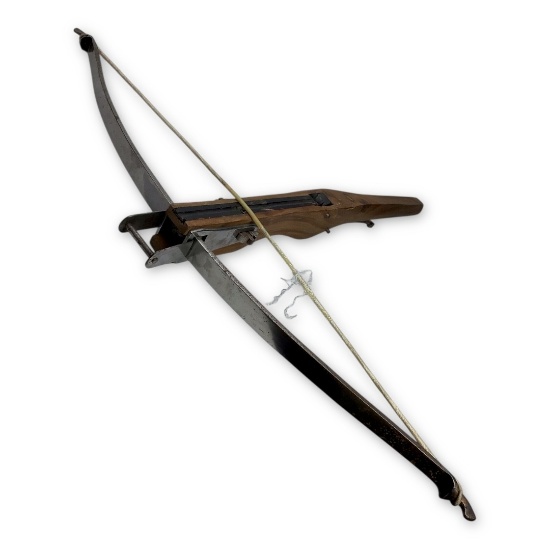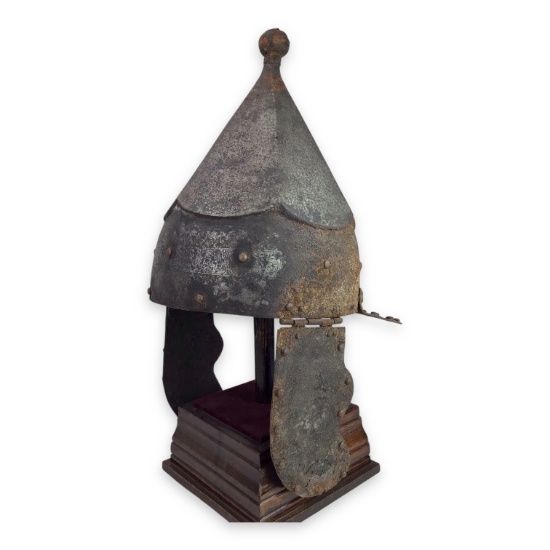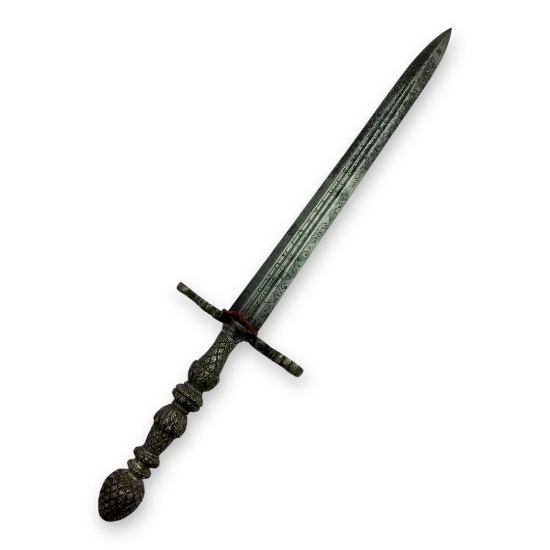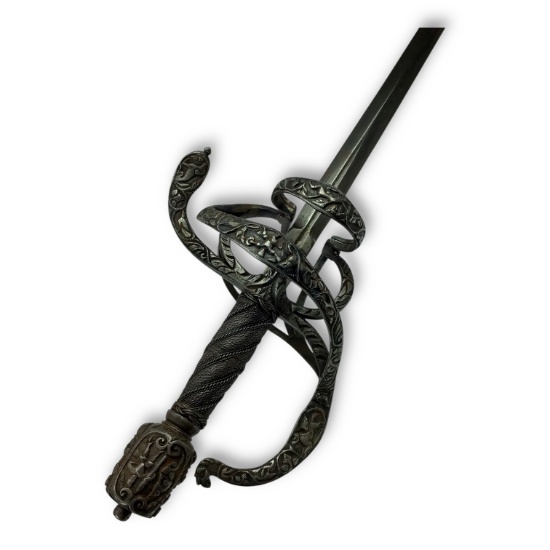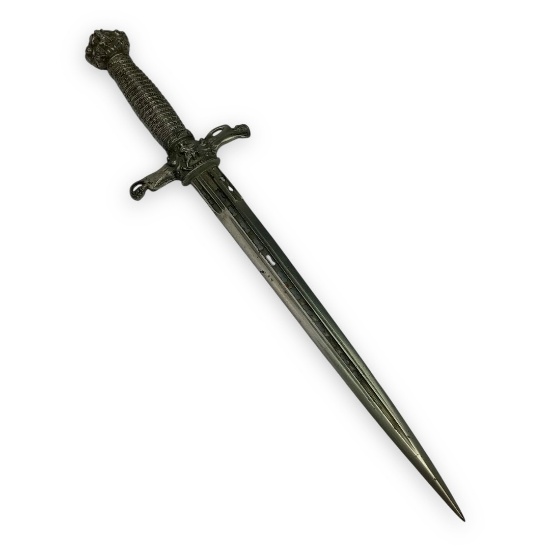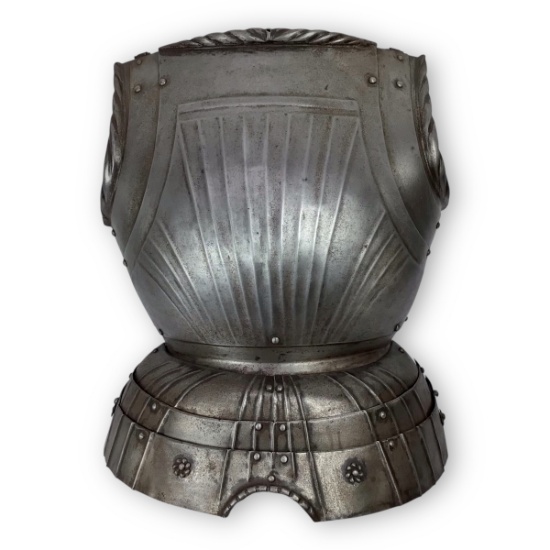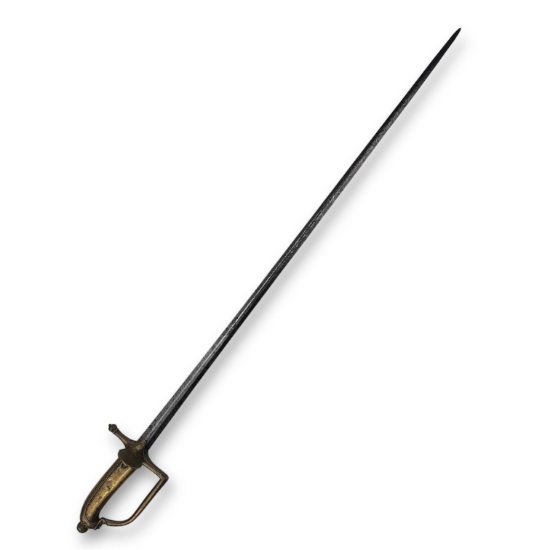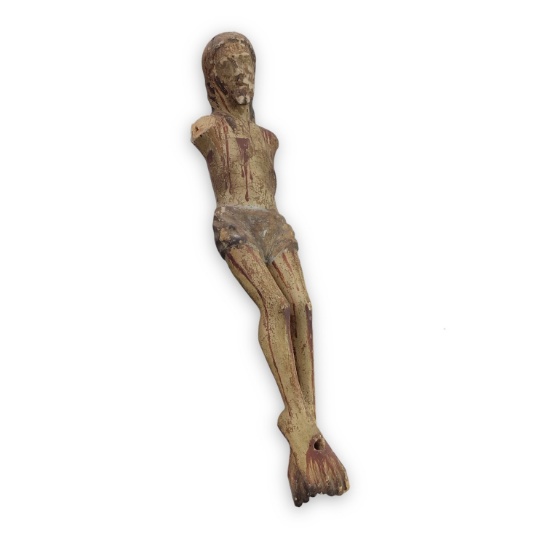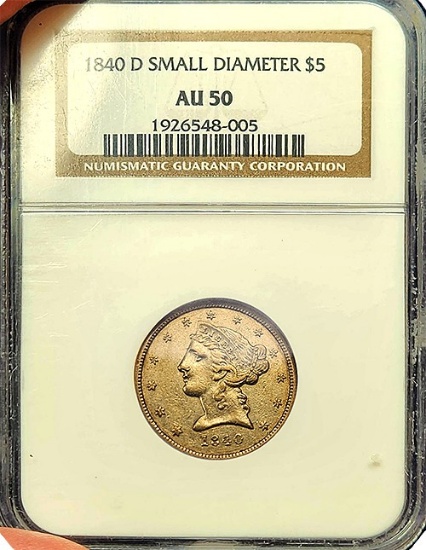
Militaria - Arms & Armor Through the Ages
Militaria - Arms & Armor Through the Ages
See Special Terms for additional fees
Description
Early Halberd circa 1500-1520
Lot # 214 (Sale Order: 51 of 273)
Functional Modern Reproduction Medieval Crossbow (Missing Stirrup)
Lot # 215 (Sale Order: 52 of 273)
17th Century European "Axe of Justice" with Original Handle - Scotland, ca. 1600
Lot # 216 (Sale Order: 53 of 273)
Medieval Helmet - Inscribed and Etched Designs
Lot # 217 (Sale Order: 54 of 273)
Italian Silver Stiletto - 17th-18th Century, Double Fuller, Engraved Blade
Lot # 300 (Sale Order: 55 of 273)
Its slender profile and rigid blade made it ideal for thrusting through gaps in armor or between ribs. The stiletto was a favored weapon in Renaissance and Baroque Italy, especially in urban environments where its concealed carry and precision were prized.
It was associated with nobles, bodyguards, and duelists, and became infamous for its use in assassination and intrigue. Silver-hilted examples like this were not only weapons but also symbols of refinement and fashion.
Chiseled Swept-Hilt Rapier - Damascus Blade and ornate Gold Inlays
Lot # 301 (Sale Order: 56 of 273)
The blade is a stunning Damascus steel example, marked at the ricasso and embellished with a gold inlaid maker's stamp near the forte. While the exact origin remains unclear, the piece is believed to be 90% original and may be a Victorian-era homage to 17th-century originals. Rapiers like this were originally popular during the late Renaissance and early Baroque periods, used primarily by gentlemen for civilian self-defense and dueling.
The sweeping guard offered superior hand protection during thrust-based fencing styles. By the Victorian era, many wealthy collectors commissioned high-quality reproductions of Renaissance arms for decorative or ceremonial use, often retaining the exquisite attention to detail seen in this example. Whether original or reproduction, this sword is a stunning representation of craftsmanship and martial elegance spanning centuries.
Continental European Dagger c. 1810 with Leather & Metal Sheath
Lot # 302 (Sale Order: 57 of 273)
Daggers like this were often privately owned sidearms used by military officers or civilians during the Napoleonic era. The 1810s were a turbulent period across Europe with Napoleon's military campaigns redefining national borders and warfare tactics.
Knives and daggers served not only as weapons but also as status symbols. This piece, with its honest wear and practical design, reflects the transitional craftsmanship between ornate court blades and practical field tools.
Masonic Sword with Named Blade and Sheath
Lot # 303 (Sale Order: 58 of 273)
Italian or French Renaissance Nobleman's Left-Hand Dagger - Museum Grade
Lot # 304 (Sale Order: 59 of 273)
During the 16th and 17th centuries, left-hand daggers (or parrying daggers) were essential tools in civilian dueling culture. Noblemen trained in fencing carried these to deflect strikes and counterattack, balancing the long thrusting rapier in the other hand.
This piece exemplifies the period's artistry and martial elegance, an extraordinary museum-grade artifact.
German Maximilian 16th Century Style Breastplate & Articulated Skirt Cuirass Armor
Lot # 305 (Sale Order: 60 of 273)
English Cromwellian Lobster-Tail Burgonet Helmet - Circa 1630-1660
Lot # 306 (Sale Order: 61 of 273)
French Briquet Cutlass Model 1767 Old Monarchy of a "swashbuckler"
Lot # 308 (Sale Order: 63 of 273)
French 18th Century Nobleman's Hunting Sword-Dagger with Agate Handle and Silver Mounts
Lot # 309 (Sale Order: 64 of 273)
Antique Wooden Crucifix Figure of Christ - Missing Arms
Lot # 310 (Sale Order: 65 of 273)
17th-Century Large Wooden Carved Altar Statue - Saint Francis (Missing Arms)
Lot # 311 (Sale Order: 66 of 273)
Saint Francis was often portrayed in a robe with a tonsured head, reflecting humility and connection to nature.
This example, part of the Samuel Presley Nesmith Jr. Texas Museum of Military History Collection, is a compelling artifact of Catholic devotional life in the early modern era.
17th-Century Carved Wooden Religious Altar Statue - Saint Francis (Medium, Missing Arms)
Lot # 312 (Sale Order: 67 of 273)
Such ecclesiastical carvings were created for use in churches, chapels, or home altars, often in colonial Latin America or Southern Europe. Their wear and losses are part of their journey, tokens of centuries of veneration.
This piece hails from the Samuel Presley Nesmith Jr. Texas Museum of Military History Collection (2020) and embodies the spiritual and artistic legacy of early Christian craftsmanship.
17th-18th Century Irish Brass-Barreled Flintlock Blunderbuss - "Dublin" Marked
Lot # 313 (Sale Order: 68 of 273)
The stock itself is richly grained, with a silver shield inset into the wood, though a small section is missing near the ramrod channel. Blunderbusses were short-barreled, muzzle-loading firearms designed for close-quarters defense, commonly used aboard ships, by carriage guards, and in urban warfare. Their wide mouth made them ideal for scattershot loads.
Irish-made examples are especially desirable due to their craftsmanship and limited production. The engraved maker's marks and embedded silver nameplate suggest this piece may have belonged to a merchant-guard, officer, or well-connected civilian. This is a standout example of early Irish arms manufacture, blending rare provincial proofing with fine decorative embellishment. Its survival with such unique personalization makes it an incredibly rare collector's arm.
French Model 1794 Sword of the School of Mars with Belt and Scabbard
Lot # 314 (Sale Order: 69 of 273)
19th Century Gambler's Traveling Set with 4-Barrel C. Sharps Pistol
Lot # 315 (Sale Order: 70 of 273)
18th-Century Small Wooden Carved Altar Statue - Possibly Saint Francis (Missing Arms)
Lot # 316 (Sale Order: 71 of 273)
Victorian-Era Prostitute Kit with Revolver and Curios
Lot # 317 (Sale Order: 72 of 273)
Early 1900s Sailmaker's Tool - Leather and Metal Construction
Lot # 318 (Sale Order: 73 of 273)
Sailmakers were critical members of maritime crews, especially during the age of sail and into the early industrialized period. Their tools were specialized and often handmade or customized to the user's grip and workflow. This tool dates to a time when canvas sails were still common in merchant and naval fleets worldwide.
Mid-19th Century Cased Pinfire Revolver & Lund Dagger Set
Lot # 319 (Sale Order: 74 of 273)
19th Century Vampire Killing Kit of Professor Ernst Blomberg
Lot # 320 (Sale Order: 75 of 273)


 x Cancel
x Cancel
